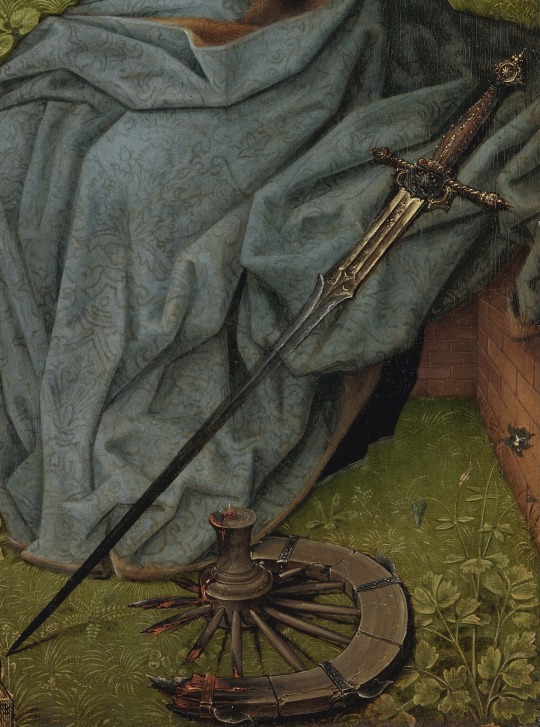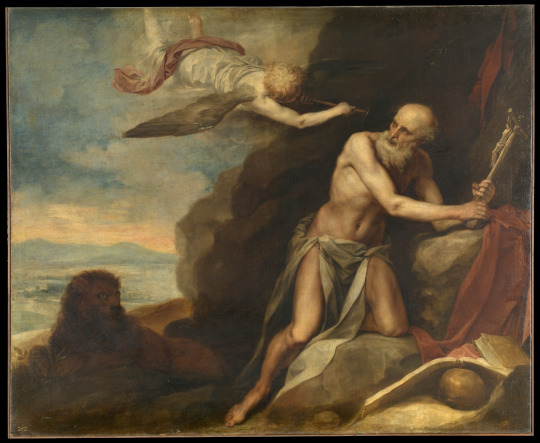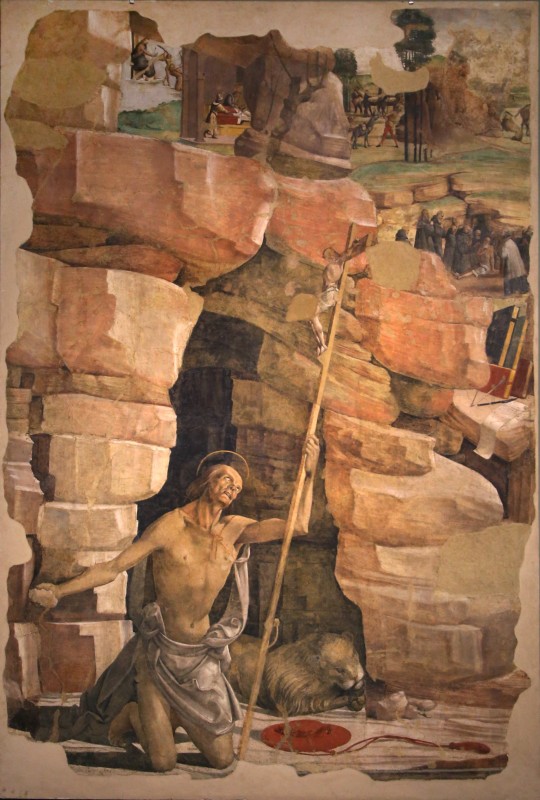#saint jerome
Text


(Details) Saint Jerome and Saint Catherine of Alexandria
Unknown artist from Bruges or Brussels, ca. 1480-90
#sword#art#history#religious art#europe#european#alexandria#saint jerome#saint catherine#medieval#middle ages#bruges#brussels
7K notes
·
View notes
Text
The Bible is a Catholic book I am very sorry to have to be the one to tell you this
#catholicism#religion#christianity#catholic#god#good#evil#Christ#Saint Jerome#:)#I can prove it#come at me#Bible
341 notes
·
View notes
Text

Jusepe de Ribera (Spanish, 1591-1652)
Saint Jerome and the Angel of Judgement, 1626
National Museum of Capodimonte
#Jusepe de Ribera#spanish art#christian art#christianity#christentum#classical art#traditional art#1500s#1600s#european#oil painting#fine arts#mediterranean#europa#europe#european art#fine art#art#saint jerome#catholicism#catholic art#catholic#christian#western civilization#hispanic
217 notes
·
View notes
Text

Nicolas Frances - Saint Jerome Translates the Gospels. Detail. 1450
116 notes
·
View notes
Text
Ignorance of Scripture is ignorance of Christ.
Saint Jerome, Prologue to his Commentary on Isaiah.
If you want Jesus without the Bible, you end up getting neither.
Mike Winger
126 notes
·
View notes
Photo

Madonna mit Kind, dem heiligen Hieronymus, dem heiligen Bernhardin und Engeln, um 14601470. von Sano di Pietro (Undatiert, )
#kunst#kunstwerk#art#artwork#sano di pietro#religiöse kunst#religious art#madonna#kind#child#heiliger hieronymus#saint jerome#heiliger bernhardin#saint bernardino#engel#angels#religion#jesus#christ#gott#god#bibel#bible#glaube#faith#beten#pray#heilig#holy
47 notes
·
View notes
Text
Latin Literature Tournament - Round 1


Propaganda under the cut!
Seneca the Younger Propaganda:
Seneca my chronically ill beloved...
His tragedies are the rawest, most gut-wrenching, and visceral pieces in pre-modern drama. His Oedipus is so fucking gnarly and it's my favorite thing ever written
I think he's super underrated as an innovator of form and genre. Between his Epistulae Morales and his tragic corpus, he was really just fucking around in the coolest way
Jerome Propaganda:
While it gets kinda paraphrastic, the Vulgate a really cool work in the history of translation, and its simple style is really clear and balanced
Describes the occurrence and cure of a sever vitamin A deficiency in the Life of Saint Hilarion, which is pretty fucking cool
Worked on onomastica, which would frankly be my personal hell, but it shows that he was brave and had the patience of, well, a saint
#tagamemnon#classics#latin#seneca#jerome#seneca the younger#saint jerome#latin literature tournament#tumblr polls#tournament polls#bracket#philosophy#theology#tragedy#drama
17 notes
·
View notes
Text

‘Saint Jerome in Meditation’ by Michelangelo Merisi da Caravaggio, c. 1606.
#Caravaggio#vintage art#classic art#art#painting#oil painting#old art#art history#vintage#moody art#art details#antique#portrait painting#dark art#saint jerome
124 notes
·
View notes
Text

Antonello da Messina, details of San Girolamo nello studio; 1474, oil on lime, 45,7x36,2 cm, Londra, National Gallery
#antonello da messina#art#painting#1400s#renaissance#renaissance art#san girolamo nello studio#saint jerome#london#londra#national gallery#details#foto#oil painting
25 notes
·
View notes
Text

Saint Jerome by Caravaggio, 1605-1606.
#classic art#painting#caravaggio#italian artist#17th century#baroque#christian art#saints#saint jerome#old man#books#skulls#black background
59 notes
·
View notes
Photo

I was going to say it’s nice to see that even as late as the 15th century we’re still getting the undying motif of the sad lion, but I enlarged this painting so you could really see St. Jerome removing the thorn from the lion’s paw and

This lion isn’t just sad, he’s traumatized.
[ID: Two images; top image is a painting of St. Jerome removing a thorn from the lion’s paw in a portico of a church; the painting advances narratively to the right, where it shows the lion returning a donkey and two camels laden with goods after the donkey was stolen by thieves. Bottom image is a detail close-up of Jerome and the lion; the lion is drawn rather figuratively, with a massive mane of hair, a frowning mouth, and huge staring eyes.]
56 notes
·
View notes
Text
Just remember, we think of the fruit in the garden because of Saint Jerome’s wild and uninhibited love of puns
#Saint Jerome#Bible#old testament#apple#garden of eden#catholic#Catholicism#very funny things happening here#Christian#Christianity#where the hell did I learn this#i forgor#LMAOOO LAST NIGHT I WAS WAY WAY TOO TIRED#FORGOT TO PUT APPLE IN THETE
16 notes
·
View notes
Text

Alonso Cano (Spanish, 1601-1667)
The penitent Saint Jerome, ca.1660
Museo Nacional del Prado
#Alonso cano#spanish art#the penitent saint jerome#saint jerome#st jerome#1600s#art#saint#christian art#christianity#christentum#catholic#roman catholic#catholic art#classic art#fine art#european art#classical art#europe#european#oil painting#fine arts#europa#mediterranean#angel#western civilization#spain#espana#spanish#hispanic
70 notes
·
View notes
Text

Bartolomeo della Gatta - Saint Jerome. 1492 - 1493
59 notes
·
View notes
Text
SAINT OF THE DAY (March 22)

March 22 is the liturgical memorial of Saint Lea of Rome, a fourth-century widow who left her wealth behind, entered consecrated life, and attained great holiness through asceticism and prayer.
Though not well-known as a figure of devotion in modern times, she was acknowledged as a saint on the testimony of her contemporary Saint Jerome, who wrote a brief description of Lea's life after she had died.
Jerome, a scholarly monk best known for his Latin translation of the Bible (the Vulgate), is the Church's only source of information on St. Lea, whose biographical details are unknown.
St. Jerome eulogized her in a letter written during the year 384 to his student and spiritual directee Marcella, another Roman consecrated woman who had left her aristocratic life behind after being widowed.
It is clear from his letter that Lea was a mutual friend to both Jerome and Marcella.
Jerome states that his account is written to “hail with joy the release of a soul, which has trampled Satan under foot, and won for itself, at last, a crown of tranquility.”
Jerome also contrasts the life of “our most saintly friend” with that of the late pagan public official, Praetextatus, held up by Jerome as a cautionary example.
“Who,” Jerome begins, “can sufficiently eulogize our dear Lea's mode of living? So complete was her conversion to the Lord that, becoming the head of a monastery, she showed herself a true mother to the virgins in it, wore coarse sackcloth instead of soft raiment, passed sleepless nights in prayer, and instructed her companions even more by example than by precept.”
Jerome describes how Lea, in her great humility, “was accounted the servant of all … She was careless of her dress, neglected her hair, and ate only the coarsest food. Still, in all that she did, she avoided ostentation that she might not have her reward in this world.”
Jerome's letter goes on to compare her fate to that of Praetextus – who died in the same year as Lea, after spending his life promoting a return to Rome's ancient polytheistic pagan religion.
The monk retells Jesus' parable of Lazarus and Dives, with Lea in the place of the poor and suffering man.
Lea, Jerome says, is “welcomed into the choirs of the angels; she is comforted in Abraham's bosom.
And, as once the beggar Lazarus saw the rich man, for all his purple, lying in torment, so does Lea see the consul, not now in his triumphal robe but clothed in mourning, and asking for a drop of water from her little finger.”
Thus Lea, “who seemed poor and of little worth, and whose life was accounted madness,” triumphs in salvation.
But the punishment of infidelity falls on the consul-elect — who had led a triumphant procession just before his death and had been widely mourned afterward.
Jerome ends his letter by urging Marcella to remember the lesson of St. Lea's life:
“We must not allow … money to weigh us down, or lean upon the staff of worldly power. We must not seek to possess both Christ and the world.
No; things eternal must take the place of things transitory; and since, physically speaking, we daily anticipate death, if we wish for immortality we must realize that we are but mortal.”
6 notes
·
View notes
Text

5 notes
·
View notes